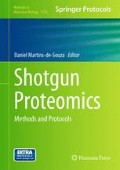Abstract
Discovery-based proteomics has found its place in nearly every facet of biological research. A key objective of this approach is to maximize sequence coverage for proteins across a wide concentration range. Fractionating samples at the protein level is one of the most common ways to circumvent challenges due to sample complexity and improve proteome coverage. Of the available methods, one-dimensional sodium dodecyl sulfate-polyacrylamide gel electrophoresis followed by liquid chromatography-tandem mass spectrometry (GeLC-MS/MS) is a robust and reproducible method for qualitative and quantitative proteomic analysis. Here we describe a general GeLC-MS/MS protocol and include technical advice and outline caveats to increase the probability of a successful analysis.
Access this chapter
Tax calculation will be finalised at checkout
Purchases are for personal use only
References
Zubarev RA (2013) The challenge of the proteome dynamic range and its implications for in-depth proteomics. Proteomics 13:723–726
Michelsen U, von Hagen J (2009) Isolation of subcellular organelles and structures. Methods Enzymol 463:305–328
Washburn MP, Wolters D, Yates JR 3rd (2001) Large-scale analysis of the yeast proteome by multidimensional protein identification technology. Nat Biotechnol 19:242–247
Rosenfeld J, Capdevielle J, Guillemot JC et al (1992) In-gel digestion of proteins for internal sequence analysis after one- or two-dimensional gel electrophoresis. Anal Biochem 203:173–179
Hellman U, Wernstedt C, Góñez J et al (1995) Improvement of an “In-Gel” digestion procedure for the micropreparation of internal protein fragments for amino acid sequencing. Anal Biochem 224:451–455
Baldwin MA (2004) Protein identification by mass spectrometry. Mol Cell Proteomics 3:1–9
Chalkley RJ, Hansen KC, Baldwin MA (2005) Bioinformatic methods to exploit mass spectrometric data for proteomic applications. Methods Enzymol 402:289–312
Kessner D, Chambers M, Burke R et al (2008) ProteoWizard: open source software for rapid proteomics tools development. Bioinformatics (Oxford, England) 24:2534–2536
Zhang Y, Fonslow BR, Shan B et al (2013) Protein analysis by shotgun/bottom-up proteomics. Chem Rev 113:2343–2394
Ericsson C, Nistér M (2011) Protein extraction from solid tissue. Methods Mol Biol (Clifton, NJ) 675:307–312
Jiang L, He L, Fountoulakis M (2004) Comparison of protein precipitation methods for sample preparation prior to proteomic analysis. J Chromatogr A 1023:317–320
Havlis J, Thomas H, Sebela M et al (2003) Fast-response proteomics by accelerated in-gel digestion of proteins. Anal Chem 75:1300–1306
Perkins DN, Pappin DJ, Creasy DM et al (1999) Probability-based protein identification by searching sequence databases using mass spectrometry data. Electrophoresis 20:3551–3567
Craig R, Beavis RC (2004) TANDEM: matching proteins with tandem mass spectra. Bioinformatics (Oxford, England) 20:1466–1467
Clauser KR, Baker P, Burlingame AL (1999) Role of accurate mass measurement (+/− 10 ppm) in protein identification strategies employing MS or MS/MS and database searching. Anal Chem 71:2871–2882
Chalkley RJ, Baker PR, Hansen KC et al (2005) Comprehensive analysis of a multidimensional liquid chromatography mass spectrometry dataset acquired on a quadrupole selecting, quadrupole collision cell, time-of-flight mass spectrometer: I. How much of the data is theoretically interpretable by search engines? Mol Cell Proteomics MCP 4:1189–1193
Chalkley RJ, Baker PR, Huang L et al (2005) Comprehensive analysis of a multidimensional liquid chromatography mass spectrometry dataset acquired on a quadrupole selecting, quadrupole collision cell, time-of-flight mass spectrometer: II. New developments in protein prospector allow for reliable and comprehensive automatic analysis of large datasets. Mol Cell Proteomics MCP 4:1194–1204
Kubo K (1995) Effect of incubation of solutions of proteins containing dodecyl sulfate on the cleavage of peptide bonds by boiling. Anal Biochem 225:351–353
Chiari M, Righetti PG, Negri A et al (1992) Preincubation with cysteine prevents modification of sulfhydryl groups in proteins by unreacted acrylamide in a gel. Electrophoresis 13:882–884
Pepinsky RB (1991) Selective precipitation of proteins from guanidine hydrochloride-containing solutions with ethanol. Anal biochem 195:177–181
Lill JR, Nesatyy VJ (2012) Microwave-assisted protein staining, destaining, and in-gel/in-solution digestion of proteins. Methods Mol Biol (Clifton, NJ) 869:521–532
Shi Y, Mowery RA, Ashley J et al (2012) Abnormal SDS-PAGE migration of cytosolic proteins can identify domains and mechanisms that control surfactant binding. Protein Sci 21:1197–1209
Woods AG, Sokolowska I, Darie CC (2012) Identification of consistent alkylation of cysteine-less peptides in a proteomics experiment. Biochem Biophys Res Commun 419:305–308
Choudhary G, Wu S-L, Shieh P et al (2003) Multiple enzymatic digestion for enhanced sequence coverage of proteins in complex proteomic mixtures using capillary LC with Ion trap MS/MS. J Proteome Res 2:59–67
Swaney DL, Wenger CD, Coon JJ (2010) Value of using multiple proteases for large-scale mass spectrometry-based proteomics. J Proteome Res 9:1323–1329
Speicher K, Kolbas O, Harper S et al (2000) Systematic analysis of peptide recoveries from in-gel digestions for protein identifications in proteome studies. J Biomol Tech JBT 11:74–86
Hsieh EJ, Bereman MS, Durand S et al (2013) Effects of column and gradient lengths on peak capacity and peptide identification in nanoflow LC-MS/MS of complex proteomic samples. J Am Soc Mass Spectrom 24:148–153
Swaney DL, McAlister GC, Coon JJ (2008) Decision tree-driven tandem mass spectrometry for shotgun proteomics. Nat Methods 5:959–964
Author information
Authors and Affiliations
Corresponding author
Editor information
Editors and Affiliations
Rights and permissions
Copyright information
© 2014 Springer Science+Business Media New York
About this protocol
Cite this protocol
Dzieciatkowska, M., Hill, R., Hansen, K.C. (2014). GeLC-MS/MS Analysis of Complex Protein Mixtures. In: Martins-de-Souza, D. (eds) Shotgun Proteomics. Methods in Molecular Biology, vol 1156. Humana Press, New York, NY. https://doi.org/10.1007/978-1-4939-0685-7_4
Download citation
DOI: https://doi.org/10.1007/978-1-4939-0685-7_4
Published:
Publisher Name: Humana Press, New York, NY
Print ISBN: 978-1-4939-0684-0
Online ISBN: 978-1-4939-0685-7
eBook Packages: Springer Protocols

